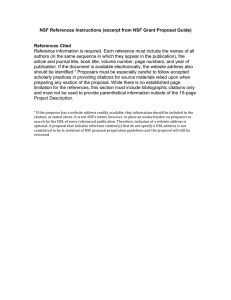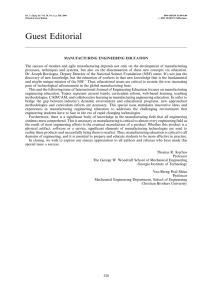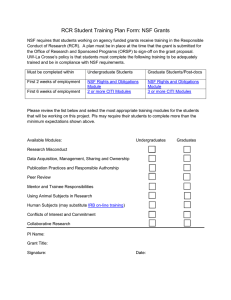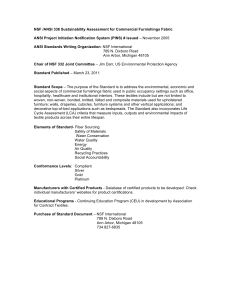NEWS&ANALYSIS
advertisement
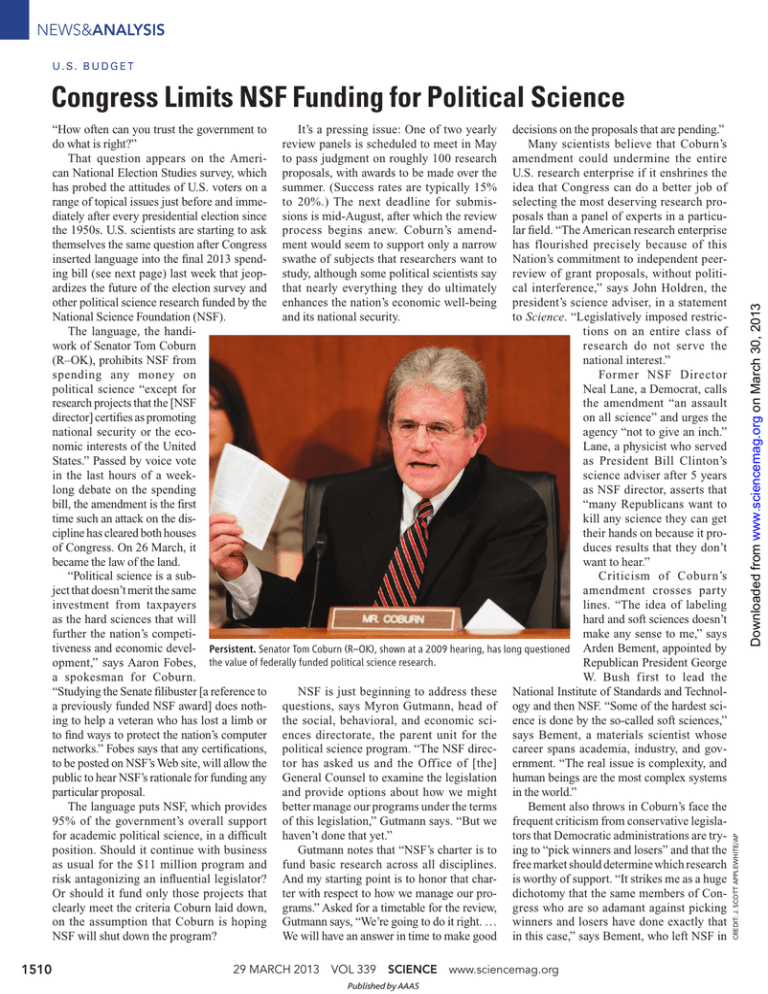
NEWS&ANALYSIS U.S. BUDGET 1510 29 MARCH 2013 VOL 339 SCIENCE Published by AAAS www.sciencemag.org CREDIT: J. SCOTT APPLEWHITE/AP “How often can you trust the government to It’s a pressing issue: One of two yearly decisions on the proposals that are pending.” do what is right?” review panels is scheduled to meet in May Many scientists believe that Coburn’s That question appears on the Ameri- to pass judgment on roughly 100 research amendment could undermine the entire can National Election Studies survey, which proposals, with awards to be made over the U.S. research enterprise if it enshrines the has probed the attitudes of U.S. voters on a summer. (Success rates are typically 15% idea that Congress can do a better job of range of topical issues just before and imme- to 20%.) The next deadline for submis- selecting the most deserving research prodiately after every presidential election since sions is mid-August, after which the review posals than a panel of experts in a particuthe 1950s. U.S. scientists are starting to ask process begins anew. Coburn’s amend- lar field. “The American research enterprise themselves the same question after Congress ment would seem to support only a narrow has flourished precisely because of this inserted language into the final 2013 spend- swathe of subjects that researchers want to Nation’s commitment to independent peering bill (see next page) last week that jeop- study, although some political scientists say review of grant proposals, without politiardizes the future of the election survey and that nearly everything they do ultimately cal interference,” says John Holdren, the other political science research funded by the enhances the nation’s economic well-being president’s science adviser, in a statement National Science Foundation (NSF). and its national security. to Science. “Legislatively imposed restricThe language, the handitions on an entire class of work of Senator Tom Coburn research do not serve the (R–OK), prohibits NSF from national interest.” spending any money on Former NSF Director political science “except for Neal Lane, a Democrat, calls research projects that the [NSF the amendment “an assault director] certifies as promoting on all science” and urges the national security or the ecoagency “not to give an inch.” nomic interests of the United Lane, a physicist who served States.” Passed by voice vote as President Bill Clinton’s in the last hours of a weekscience adviser after 5 years long debate on the spending as NSF director, asserts that bill, the amendment is the first “many Republicans want to time such an attack on the diskill any science they can get cipline has cleared both houses their hands on because it proof Congress. On 26 March, it duces results that they don’t became the law of the land. want to hear.” “Political science is a subCriticism of Coburn’s ject that doesn’t merit the same amendment crosses party investment from taxpayers lines. “The idea of labeling as the hard sciences that will hard and soft sciences doesn’t further the nation’s competimake any sense to me,” says tiveness and economic devel- Persistent. Senator Tom Coburn (R–OK), shown at a 2009 hearing, has long questioned Arden Bement, appointed by opment,” says Aaron Fobes, the value of federally funded political science research. Republican President George a spokesman for Coburn. W. Bush first to lead the “Studying the Senate filibuster [a reference to NSF is just beginning to address these National Institute of Standards and Technola previously funded NSF award] does noth- questions, says Myron Gutmann, head of ogy and then NSF. “Some of the hardest sciing to help a veteran who has lost a limb or the social, behavioral, and economic sci- ence is done by the so-called soft sciences,” to find ways to protect the nation’s computer ences directorate, the parent unit for the says Bement, a materials scientist whose networks.” Fobes says that any certifications, political science program. “The NSF direc- career spans academia, industry, and govto be posted on NSF’s Web site, will allow the tor has asked us and the Office of [the] ernment. “The real issue is complexity, and public to hear NSF’s rationale for funding any General Counsel to examine the legislation human beings are the most complex systems particular proposal. and provide options about how we might in the world.” The language puts NSF, which provides better manage our programs under the terms Bement also throws in Coburn’s face the 95% of the government’s overall support of this legislation,” Gutmann says. “But we frequent criticism from conservative legislafor academic political science, in a difficult haven’t done that yet.” tors that Democratic administrations are tryposition. Should it continue with business Gutmann notes that “NSF’s charter is to ing to “pick winners and losers” and that the as usual for the $11 million program and fund basic research across all disciplines. free market should determine which research risk antagonizing an influential legislator? And my starting point is to honor that char- is worthy of support. “It strikes me as a huge Or should it fund only those projects that ter with respect to how we manage our pro- dichotomy that the same members of Conclearly meet the criteria Coburn laid down, grams.” Asked for a timetable for the review, gress who are so adamant against picking on the assumption that Coburn is hoping Gutmann says, “We’re going to do it right. … winners and losers have done exactly that NSF will shut down the program? We will have an answer in time to make good in this case,” says Bement, who left NSF in Downloaded from www.sciencemag.org on March 30, 2013 Congress Limits NSF Funding for Political Science CREDIT: NASA/GSFC/BILL HRYBYK –JEFFREY MERVIS A little help … . Senator Mikulski, seen here visiting a NASA facility in her state, provided some relief for the agency. U.S. BUDGET U.S. Science Agencies Finally Have (Reduced) Budgets for This Year U.S. research agencies finally know their budgets for the rest of the fiscal year after Congress completed work last week on a bill to fund the government through 30 September. Although the Senate managed to reduce the pain for some programs, only one has more to spend than in 2012. Agency heads are now in the process of finalizing 2013 spending plans, which must then be approved by Congress. A few agencies, notably the National Science Foundation (NSF) and NASA, received more money— and were given more flexibility—than they would have had under the spending bill approved by the House of Representatives. (The bill is known as a continuing resolution [CR] because it basically freezes agency budgets at 2012 levels.) However, no agency has been spared the $85 billion, across-the-board reduction known as sequestration that went into effect on 1 March. So every civilian agency, even the “winners,” must subtract 5% from whatever Congress has now given them, a cut that is effectively 9% because the reduction must be absorbed with only 7 months left in the fiscal year. Confused? You’re not alone. Sequestration, the first year of a decadelong process to slice $1.2 trillion from the federal budget, wasn’t supposed to happen because both parties agreed that its mandatory provisions were “stupid,” if not “devastating.” But the Republican-led House inserted it into its version of the $984 billion CR and passed it on 6 March. The Senate, despite its Democratic majority, accepted the House approach and instead made some tweaks at the margins before passing its bill on 20 March. Less than 24 hours later, the House signed off on the Senate version and then recessed for a 2-week Easter break. www.sciencemag.org SCIENCE VOL 339 Published by AAAS Downloaded from www.sciencemag.org on March 30, 2013 2010 to become director of the Global Policy Research Institute at Purdue University. The American National Election Studies (electionstudies.org) runs one of two large ongoing studies funded by NSF’s political science program. (The General Social Survey, run by the University of Chicago, is the other.) The election survey was first fielded in 1952 and has been copied by dozens of nations since then, says Vincent Hutchings of the University of Michigan. He’s a principal investigator for the survey, done jointly with Stanford University and currently funded by a 5-year, $10 million NSF grant that runs through 2014. “It’s become the gold standard for understanding how your democracy works,” Hutchings says. The survey’s most valuable element, he notes, is its long time series. “That stability allows us to ask the same question to a national representative sample—like voters’ trust in government—and understand whether it has gone up or down over decades.” The hourlong survey, conducted mostly in person, has helped scientists understand basic concepts such as party identification and its relationship to voter turnout. And while Hutchings says the survey’s scientific rigor has been the litmus test for ongoing NSF support (he’s awaiting a call for proposals this spring to support work on the 2016 elections), he also believes that it could meet Coburn’s narrow definition. “How a country thinks about its political system is certainly a component of national security,” he says. The amendment technically applies only to NSF grants made during the rest of the 2013 fiscal year, which ends on 30 September. But unless Congress passes NSF’s 2014 spending bill on time, a vanishingly rare occurrence these days, the guidelines would extend into the new fiscal year. (After that, Congress would have to renew it annually.) Jim Granato, who co-managed NSF’s political science program in the early 2000s and is now director of the Hobby Center for Public Policy at the University of Houston in Texas, thinks that Coburn may achieve his goal in the short run. “I think people will be risk-averse,” says Granato, who has a proposal pending before the spring panel. “Writing a proposal takes a lot of time, and NSF already has two criteria that proposals must meet—intellectual merit and broader impacts. I expect what they’ll do is call up NSF and ask [program officer] Brian [Humes] what they should do.” “I feel sorry for Brian,” Granato adds. “It’s going to be total chaos.” The Senate pulled NSF, NASA, and six Cabinet departments out of the CR and gave them a regular appropriations bill, thanks to an agreement between the chair of the appropriations committee, Senator Barbara Mikulski (D–MD), and its ranking member, Senator Richard Shelby (R–AL). That agreement, for example, allowed Mikulski to increase the appropriation for several NSF programs beyond what they would have received under the CR and offset more than half of the $356 million sequester, bringing NSF’s overall 2013 budget to $6.88 billion. Unfortunately, that’s still $150 million below its 2012 level. Similarly, NASA received $45 million more for planetary sciences than it would have gotten under the CR. That’s a boon for further Mars exploration and for planning a possible visit to Jupiter’s moon Europa. In the one exception, the National Oceanic and Atmospheric Administration (NOAA) will get a boost of about $300 million, with funding from a Superstorm Sandy relief bill approved earlier this year offsetting the impact of the sequester. The final legislation also gives NOAA greater budget flexibility in building new weather satellites and upgrading research aircraft. In contrast, the National Institutes of Health remains under the continuing resolution. Legislators tossed it a $67 million crumb, but that’s hardly enough to ease the pain of the $1.5 billion sequester for researchers whose work is dependent on the $31 billion agency. More details from the final 2013 spending bill are available at http://scim.ag/CR-2013. And there’s no rest for the budget-weary: The Obama administration’s wish list for science will be included in the president’s 2014 budget submission to Congress, due out the week of 8 April. –JEFFREY MERVIS 29 MARCH 2013 1511

